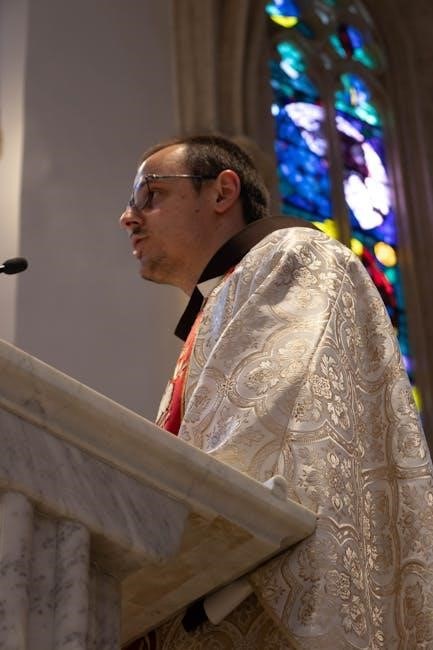Palm Sunday commemorates Jesus’ triumphal entry into Jerusalem, symbolizing victory and humility. It marks the beginning of Holy Week, blending celebration with impending sacrifice.
1.1. Historical Context of Palm Sunday
Palm Sunday occurs the week before Easter, commemorating Jesus’ triumphant entry into Jerusalem. This event marked a pivotal moment in His ministry, as He was welcomed by crowds waving palm branches, symbolizing peace and victory. Historically, Jerusalem was a center of Jewish faith, and Jesus’ arrival coincided with the Passover, drawing large crowds. The donkey He rode signified humility, contrasting with the grandeur of royal processions. The crowd’s chant of “Hosanna” expressed their hope for salvation, yet many misunderstood His mission. This event initiated Holy Week, leading to His crucifixion and resurrection, core to Christian belief. The historical context underscores the tension between celebration and impending sacrifice.
1.2. Significance of Palm Sunday in Christian Tradition
Palm Sunday holds profound significance in Christian tradition as it marks the beginning of Holy Week, a period of reflection and celebration. It symbolizes Jesus’ triumphal entry into Jerusalem, where He was welcomed with palm branches, representing victory and peace. This event is a reminder of Jesus’ divine nature and His mission of salvation. Christians observe this day to honor His humility and sacrifice, which ultimately led to His resurrection. The use of palms in worship services and processions reflects the crowd’s ancient gesture of adoration. Palm Sunday serves as a powerful reminder of God’s love and redemption, setting the stage for Easter’s celebration of resurrection and eternal life.
1.3. Overview of the Triumphal Entry
The Triumphal Entry marks Jesus’ deliberate and symbolic journey into Jerusalem, fulfilling ancient prophecies. Riding a donkey, He embodies humility and peace, contrasting with royal conquests. Crowds greeted Him with palm branches, shouting “Hosanna,” signifying their hope for salvation. This event, days before His crucifixion, showcased His divine authority and willingness to embrace sacrifice. The donkey symbolized humility, while the palms represented victory and surrender. The crowd’s actions reflected their expectation of a Messiah, though many misunderstood His mission. This moment bridges celebration and impending sacrifice, highlighting Jesus’ dual role as King and Savior, setting the stage for Holy Week’s profound events.

Key Scripture Passages for Palm Sunday
Matthew 21:1-11, Mark 11:1-11, Luke 19:28-44, and John 12:12-19 are central to Palm Sunday, detailing Jesus’ triumphant entry into Jerusalem and its theological significance.
2.1. Matthew 21:1-11
Matthew 21:1-11 recounts Jesus’ triumphal entry into Jerusalem, where He fulfilled Zechariah’s prophecy by riding a donkey, symbolizing humility and peace. The crowd, recognizing Him as the Messiah, waved palm branches and shouted, “Hosanna!” This passage highlights Jesus’ deliberate act of humility, contrasting with earthly kingship, and demonstrates His divine authority. The event marks the beginning of Holy Week, leading to His crucifixion. Preachers often emphasize the crowd’s declaration of Jesus as the Son of David, underscoring His messianic identity and the people’s expectation of salvation. This passage is central to Palm Sunday, illustrating Jesus’ fulfillment of prophecy and His mission of redemption.
2.2. Mark 11:1-11
Mark 11:1-11 describes Jesus’ triumphal entry into Jerusalem, emphasizing His intentional fulfillment of prophecy. Jesus instructed His disciples to fetch a donkey, symbolizing humility, and the crowd’s enthusiastic response highlighted His messianic identity. The passage underscores the urgency of Jesus’ mission, as He cleansed the temple afterward. Preachers often highlight the crowd’s use of palm branches and their declaration of Jesus as the “Son of David,” reflecting their expectation of a deliverer. This passage serves as a powerful reminder of Jesus’ authority and His ultimate purpose, making it a key text for Palm Sunday reflections on His kingship and redemption.
2.3. Luke 19:28-44
Luke 19:28-44 vividly recounts Jesus’ triumphal entry into Jerusalem, highlighting His divine authority and the crowd’s joyful yet misunderstood expectations. Jesus weeps over the city, foreseeing its destruction, emphasizing His deep emotional investment. The passage also includes the cleansing of the temple, showcasing His zeal for God’s house. Preachers often focus on the contrast between celebration and impending sorrow, urging believers to reflect on their response to Jesus. This text uniquely captures the dual nature of Jesus’ mission—bringing salvation while confronting sin. It invites congregations to consider their own worship and commitment to Christ, aligning their lives with His kingdom purposes.
2.4. John 12:12-19
John 12:12-19 details Jesus’ entry into Jerusalem, where the crowd waves palm branches, hailing Him as the Son of David. This passage emphasizes the fulfillment of prophecy, as Jesus rides a donkey, symbolizing humility and peace. The Pharisees’ concern highlights the growing tension, while the disciples later understand the significance of the event. Preachers often explore themes of worship, kingship, and redemption, noting the crowd’s mixture of excitement and misunderstanding. This text underscores Jesus’ identity as Messiah and the cosmic implications of His mission, offering a powerful narrative for reflecting on faith and commitment to Christ’s kingdom.

Theological Themes in Palm Sunday
Palm Sunday explores Jesus as Messiah and King, revealing God’s kingdom as one of humility and salvation. It highlights redemption, worship, and the paradox of divine authority.
3.1. Jesus as the Messiah and King
Jesús entering Jerusalén on a donkey symbolizes His humble yet divine kingship, fulfilling prophecies of the Messiah. This act declares His authority while embodying servant-leadership, contrasting earthly power with God’s kingdom.
3.2. The Nature of God’s Kingdom
God’s kingdom, as revealed in Palm Sunday, is rooted in divine love and humility, not earthly power. Jesus’ triumphal entry contrasts with worldly kingdoms, emphasizing spiritual authority. The crowd’s expectation of a political savior highlights their misunderstanding of God’s kingdom, which prioritizes love, forgiveness, and redemption over domination. This event underscores the kingdom’s paradoxical nature—victory through sacrifice, reign through service, and power through humility. Jesus’ kingship is not about conquest but about transforming hearts, inviting all to participate in His redemptive plan. This challenges believers to align their lives with God’s kingdom values, prioritizing spiritual truths over temporal ambitions.
3.3. Salvation and Redemption
Palm Sunday highlights Jesus’ mission of salvation and redemption, fulfilling Old Testament prophecies. His entry into Jerusalem symbolizes God’s plan to rescue humanity from sin. The event foreshadows the cross, where salvation was secured through Christ’s sacrifice. The crowd’s Hosannas reflect their longing for deliverance, while Jesus’ humility on a donkey contrasts with earthly kings, showing His divine purpose. This moment emphasizes that true redemption comes not through power but through love and sacrifice. The triumphal entry invites believers to reflect on their own need for salvation and the profound grace offered through Jesus’ redemptive work, central to the Gospel message.
3.4. Worship and Humility
Palm Sunday underscores the themes of worship and humility, as Jesus’ triumphal entry into Jerusalem is marked by the crowd’s adoration and His deliberate choice to ride a donkey. The waving of palm branches and shouts of “Hosanna” symbolize the people’s surrender and praise, while Jesus’ humility contrasts with earthly displays of power. This event reminds believers that true worship involves acknowledging God’s sovereignty and submitting to His will. The donkey, a symbol of peace and meekness, highlights Jesus’ mission of redemption over conquest. This duality of worship and humility calls followers to reflect on their own posture before God, emphasizing that genuine worship is rooted in humility and surrender to His divine plan.

Cultural and Symbolic Elements
Palm Sunday richly employs cultural symbols like palm branches, donkeys, and processions, each carrying deep theological meaning that reflects Jesus’ humility, kingship, and divine mission.
4.1. The Significance of Palm Branches
Palm branches symbolize victory, peace, and jubilation, as seen in Jewish tradition. During Palm Sunday, they were waved by the crowd to honor Jesus, acknowledging Him as the Messiah and King. This act, recorded in John 12:13, reflects the people’s recognition of His divine authority and their expectation of salvation. The palms also represent humility and surrender, as they were laid on the ground before Jesus, signifying a willingness to submit to His will. This ancient practice continues in modern worship, serving as a powerful reminder of Christ’s triumphal entry into Jerusalem and the spiritual victory He brings to believers.
4.2. The Donkey as a Symbol of Humility
The donkey Jesus rode into Jerusalem embodies humility and meekness, contrasting the grandeur of royal processions. In ancient times, donkeys were beasts of burden, not majesty, symbolizing Jesus’ gentle nature. This choice emphasized His mission of peace and service over earthly power. The donkey’s presence underscores Jesus’ fulfillment of Zechariah’s prophecy, highlighting His role as a humble King. By riding a donkey, Jesus demonstrated His willingness to embrace simplicity and serve humanity, teaching believers the value of humility in their walk with God. This profound imagery reinforces the heart of Christ’s ministry: love, sacrifice, and surrender.
4.3. The Crowd’s Reaction and Expectations
The crowd’s reaction to Jesus’ entry was a mix of excitement and misunderstanding. They waved palm branches, shouting “Hosanna,” anticipating a political savior to overthrow Roman rule. Many expected a mighty warrior-king, not a humble servant. Their expectations were rooted in Jewish Messianic hopes, yet they overlooked Jesus’ true mission of spiritual redemption. This disparity highlights the tension between earthly ambitions and divine purposes. The crowd’s enthusiasm, while genuine, was short-lived, as their hopes were soon shattered by the events leading to the cross. This narrative serves as a reminder of the importance of aligning our expectations with God’s plan rather than our own desires.

Preaching Tips for Palm Sunday
Engage the congregation by highlighting the triumphal entry’s contrast with impending sacrifice. Use storytelling to connect the event to modern life, emphasizing worship, humility, and redemption.
5.1. Engaging the Congregation
To engage the congregation on Palm Sunday, consider beginning with a reflective prayer or hymn that sets the tone for the day. Share personal anecdotes or relatable stories that connect the triumphal entry to modern experiences, making the event feel relevant. Encourage participation through responsive readings, where the congregation can echo the crowd’s praises from the Bible. Visual aids, such as images of palm branches or Jerusalem, can enhance the message. Additionally, invite the congregation to reflect on how they, like the crowd, might have expectations of Jesus that He exceeds in unexpected ways. This fosters a deeper connection to the narrative.
5.2. Connecting the Event to Modern Life
Palm Sunday’s narrative offers timeless lessons for modern Christians. The triumphal entry reflects the human desire for a savior, mirroring today’s longing for hope and redemption. Just as the crowd sought a victorious king, many today seek fulfillment in power, status, or materialism. Jesus’ humble arrival contrasts with worldly expectations, teaching us that true victory lies in humility and love. Encourage congregants to reflect on how they, like the crowd, may have preconceived notions of God’s work in their lives. Invite them to embrace the paradox of a Savior who conquers through sacrifice, offering a different kind of victory—one of heart and spirit.
5.3. Using Storytelling Techniques
Storytelling is a powerful tool for engaging congregants during Palm Sunday sermons. Paint a vivid picture of Jesus’ triumphal entry, emphasizing the crowd’s excitement and the symbolic act of laying palm branches. Share personal reflections or hypothetical scenarios to connect the ancient event to modern life. Highlight the contrast between the crowd’s expectations of a conquering king and Jesus’ humble arrival on a donkey. Use descriptive language to evoke emotions, such as the joy of celebration or the tension of impending betrayal. Encourage the congregation to imagine themselves in the crowd, prompting them to reflect on how they would have reacted. This approach makes the story relatable and impactful, fostering a deeper connection to the narrative.

Sermon Outline Examples
Engage your congregation by weaving the story of Jesus’ triumphal entry into Jerusalem. Use vivid imagery to describe the crowd’s excitement and the symbolic act of laying palm branches. Share personal reflections or hypothetical scenarios to connect the ancient event to modern life. Highlight the contrast between the crowd’s expectations of a conquering king and Jesus’ humble arrival on a donkey. Encourage the congregation to imagine themselves in the story, prompting them to reflect on how they would have reacted. This approach fosters a deeper emotional and spiritual connection to the narrative.
6.1. “The King is Coming” (Luke 19:28-44)
This sermon outline explores Jesus’ triumphal entry into Jerusalem, emphasizing His identity as the Messiah and King. Begin with an introduction highlighting the significance of the event. Discuss the preparations made by Jesus and the disciples, symbolizing purpose and fulfillment of prophecy; Emphasize the crowd’s reaction, their expectations of a conquering king, and the symbolism of the donkey as humility. Conclude by connecting the event to modern life, urging the congregation to reflect on their own expectations of Jesus and how He challenges worldly perceptions of power and leadership. Encourage a response of worship and surrender to the King who brings salvation.
6.2. “Life-Changing Expectations” (Matthew 21:8-11)
This sermon focuses on the crowd’s expectations of Jesus as He entered Jerusalem. Explore how their hopes for a political savior clashed with Jesus’ true mission of spiritual redemption. Analyze the text to reveal the tension between celebration and misunderstanding. Discuss the life-changing implications of Jesus’ arrival, emphasizing His fulfillment of prophecy and divine purpose. Conclude by challenging the congregation to examine their own expectations of Jesus, inviting them to embrace His transformative power in their lives. Encourage a response of faith, aligning their expectations with God’s plan of salvation and redemption.
6.3. “Who is Jesus?” (John 12:12-19)
This sermon centers on John’s account of Palm Sunday, focusing on the question, “Who is Jesus?” Explore the crowd’s perception of Jesus as a king, contrasting it with His divine identity. Analyze how Jesus’ actions, such as riding a donkey, symbolize humility and fulfillment of prophecy. Highlight the Pharisees’ concern and the growing belief among the people. Emphasize the universal call to recognize Jesus as the Son of God and the Savior of the world. Conclude by challenging the congregation to answer this question personally, inviting them to place their faith in Him. Use this passage to deepen understanding of Jesus’ identity and mission.

Practical Application of the Sermon
Reflect on Jesus’ humility and sacrifice, then make a public choice for Christ, embracing worship and service in daily life with gratitude and purpose.
7.1. Reflecting on Jesus’ Entry into Jerusalem
Reflecting on Jesus’ triumphal entry into Jerusalem highlights His humility and purpose. The use of a donkey symbolizes meekness, contrasting with royal processions. Crowds waving palm branches expressed hope for salvation, yet misunderstood His mission. This event reveals Jesus’ divine authority and fulfillment of prophecy. It invites believers to examine their expectations of Jesus and align them with His true nature. By reflecting on this moment, we are reminded to humbly follow Christ, embracing sacrifice and service. This reflection deepens our understanding of His kingdom and our role in it, preparing us to live out His teachings with authenticity and devotion.
7.2. Making a Public Choice for Christ
Making a public choice for Christ involves boldly declaring one’s faith, mirroring the crowd’s actions on Palm Sunday. Like the crowd waving palm branches, believers today must visibly demonstrate their allegiance to Jesus. This choice requires courage, as it may lead to challenges or scrutiny. By publicly identifying with Christ, individuals affirm His authority and grace in their lives. It encourages others to consider their own relationship with Him. A public choice for Christ fosters accountability and deepens personal commitment, reflecting the humility and sacrifice modeled during His triumphal entry. This act of faith becomes a powerful witness, inspiring others to follow Him wholeheartedly.
7.3. The Role of Worship in Daily Life
Worship is not confined to Sundays; it is a lifestyle rooted in reverence for God. Daily worship involves prayer, gratitude, and living with integrity. By acknowledging God in all aspects of life, believers reflect His presence and purpose. Worship in daily life fosters humility, joy, and a deeper connection with Christ. It transforms mundane tasks into acts of devotion, aligning one’s heart with God’s will. Just as the crowd worshipped Jesus with palm branches, believers today can honor Him through faithful living, making every moment an opportunity to glorify Him. This practice strengthens faith and inspires others to seek a personal relationship with Christ.
Palm Sunday reminds us of Jesus’ triumphal entry, symbolizing victory and humility. Reflect on His sacrifice, resurrection, and the hope of Easter. Live faithfully, inspired by His love.
8.1. Recap of Key Points
Palm Sunday reflects Jesus’ triumphal entry into Jerusalem, symbolizing His divine kingship and humility. The event highlights the crowd’s expectation of a savior and their worship through palm branches. It serves as a prelude to Easter, emphasizing themes of sacrifice, redemption, and eternal hope. The stories from Matthew, Mark, Luke, and John underscore Jesus’ mission and humanity’s response. This day calls believers to reflect on their faith journey and the true nature of God’s kingdom, offering a powerful reminder of worship, humility, and the transformative power of Christ’s love and sacrifice.
8.2. Encouragement for the Congregation
As we reflect on Palm Sunday, let us embrace the humility and love demonstrated by Jesus. May His triumphal entry inspire us to live boldly for Christ, making a public choice to follow Him. Let us worship with sincerity, remembering the true nature of God’s kingdom. This holy week, may we draw closer to Jesus, allowing His sacrifice to transform our lives. As Easter approaches, let us hold onto hope and renewal, trusting in God’s plan. May we leave here today with hearts ready to serve and share the love of Christ in our world.
8.3. Looking Ahead to Easter
As we move from Palm Sunday to Easter, let us remember the profound transition from celebration to sacrifice and ultimately to resurrection. Easter reminds us of God’s ultimate triumph over death and sin. The empty tomb symbolizes hope, renewal, and the fulfillment of Jesus’ mission. Let us reflect on the events of Holy Week, preparing our hearts for the glory of Easter. May the promise of Christ’s resurrection bring us joy, strength, and a deeper commitment to following Him. As we journey toward Easter, let us embrace the love and redemption that only Jesus can provide;

Additional Resources
- Recommended Bible commentaries for deeper study.
- Devotional materials to enhance spiritual reflection.
- Online sermon guides for preaching inspiration.
9.1. Recommended Bible Commentaries
For sermon preparation, consider these insightful Bible commentaries:
- Matthew Henry’s Commentary: Offers detailed analysis of Palm Sunday scriptures.
- The Expositor’s Bible Commentary: Provides theological depth and historical context.
- The Gospel of Matthew by John MacArthur: Explores Jesus’ triumphal entry deeply.
- The Pillar New Testament Commentary by D.A. Carson: Insightful for sermon preparation.
These resources enrich understanding and aid in crafting impactful sermons for Palm Sunday.
9.2. Devotional Materials for Palm Sunday
Enhance your Palm Sunday preparation with these devotional materials:
- Daily Reflections for Holy Week: Offers meditations from Palm Sunday to Easter.
- The Journey to the Cross by Paul David Tripp: A 7-day devotional exploring Holy Week.
- Palm Sunday to Easter Devotional: Provides daily insights and prayers.
- He Is Risen by Max Lucado: A heartfelt devotional on Jesus’ triumph and resurrection.
- Online Devotionals: Websites like YouVersion and Bible Gateway offer free Palm Sunday plans.

These resources help deepen faith and personalize the Palm Sunday experience.
9.3. Online Sermon Examples and Guides
Explore these online resources for Palm Sunday sermon inspiration and guidance:
- Palm Sunday Sermon Examples: Websites like Ministry-To-Children and Preaching Today offer free sermon outlines and full texts.
- Sermon Guides: Tools like SermonCentral provide downloadable guides and slides for Palm Sunday services.
- Video Sermons: Platforms like YouTube and Vimeo feature Palm Sunday sermons from renowned pastors.
- Lectionary Resources: Sites like WorkingPreacher.org offer commentary and sermon ideas based on Palm Sunday readings.

These resources enrich sermon preparation and delivery, offering fresh perspectives and practical tools.
